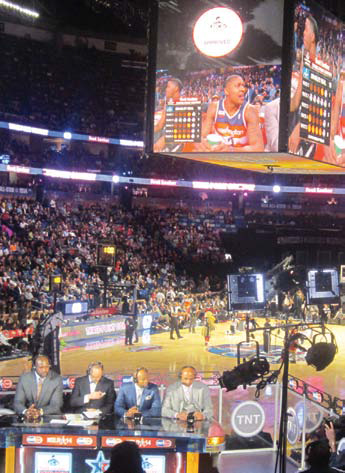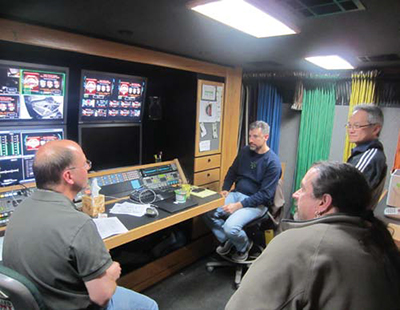TNT Covers NBA All-Star Game From All Angles
NEW ORLEANS—One word to describe the TNT broadcast of the 2014 NBA All-Star Game and its complementary events might be “immersion.” That’s an easy one, given the network’s goal having been to immerse the game’s viewers—including those in attendance on Feb. 16 at New Orleans’ Smoothie King Center—within the happy depths of basketball nirvana.
While that description nodded to various screens, it mainly referred to the immersion facilitated by TNT’s virtually all-encompassing camera angles and mic placements. The show was seen by home viewers in 215 countries (in 47 languages), the fans at the arena who enjoyed the ultra-sensory bombast of the (temporary) huge center and end zone video boards; and, of course, it was a marquee event on social media.
A key added dimension this year was TNT’s maiden voyage utilizing “freeD” (as in free dimensional) technology at selected moments during the telecast, heightening the experience while providing fans with alternate views of the action all weekend.
The game may be a glorified exhibition, but it’s become a broad celebration of the NBA that is considered by many tech hands to be a challenge to broadcast; however, it has allowed TNT to enter new areas during the three-day event, which also included special events like the BBVA NBA All-Star Rising Stars Challenge on Friday night, which included the mic-ing of eight players; and the Taco Bell Skills Challenge, the Foot Locker Three-Point Contest, and the Sprite Slam Dunk Contest on Saturday night, among others.

(L to R) Shaquille O’Neal, Ernie Johnson, Kenny Smith and Charles Barkley offered their insights and humor during the pre- and post-game shows, as well as other events during the 2014 NBA All-Star Weekend. Then came the main event.
SHOOTING THE ANGLES
With the various events already providing ample content, TNT accentuated its coverage with freeD, which was presented for the first time during an NBA contest. The technology, which was developed by Tel Aviv-based Replay Technologies and was adopted by the NFL and MLB in 2013, was implemented with 22 5K ultra-HD cameras, which were temporarily hard wired, unlike the permanent setups at Yankee Stadium and AT&T Park. With its 4K file size and installation at 360 degrees around the façade of the arena’s second deck, the system rendered unique graphics to show key moments of the game.
“We’ve seen this from Hollywood and in sports, but the technology is just now getting to where we can use it in live sports apps,” said Craig Barry, senior vice president of production and executive creative director at Turner Sports. “The render times have dropped to about a minute, then can be stabilized and melded into the broadcast.”
Get the TV Tech Newsletter
The professional video industry's #1 source for news, trends and product and tech information. Sign up below.
That setup complemented TNT’s 27 cameras, which included 16 Sony 2500 hard and handhelds; five robotics (including multiple installations behind both backboards); an RF Steadicam (one of a few hundred such channels), used for close-ups during free throws; one Phantom camera with X-MO, which hits 1,000 fps; and four super slo-mo handhelds, which shoot between 60–120 fps.
Studio operations set up in a lower corner of the arena included seven standard studio cameras, including two jibs; and entertainment segments were covered by the remaining cameras, with a jib that was only used for the musical acts and the halftime show.
But “the most interesting aspect of the overall production” Barry said, was that three trucks—the remote, which was set up (via flypack) at Musical Legends Park in the French Quarter; the studio truck; and the entertainment truck—worked in tandem.
“That’s the largest setup for the All-Star Game to date,” he said, noting the event’s 12th year on TNT, and 29th overall for Turner. “The true marvel is how these trucks interacted seamlessly,” he said.
That good news was crucial because, prior to the 2014 event, “we had never integrated the studio show into the arena. For example, before the 3-point contest, we connected with the studio show and everyone in the arena was able to watch it. The purpose was to create synergies while further integrating the fans inside into the event.”
There were nine main mobile units in the compound for the weekend events, four of which are owned and operated by Pittsburgh-based NEP Supershooters. They included the electronic setup (or ESU) truck, which served as the hub of transmission and distribution for the other trucks, with signals en route to many locales within the game’s vast broadcast universe.
Dave Greany, engineering manager for NEP, compared the ESU to a big router that directed “video, intercoms, graphics and reference for the compound,” he said. “They were all shared from that central point.”

(L to R): Dave Koenig of Turner Sports, Chris Sullivan of NEP Supershooters, Tom Sahara of Turner and Erik Bjorkquist of NEP discuss their next moves from NEP’s ESU truck during the NBA All-Star weekend. Supershooters 24 A and B, NEP’s “twin” units, served as the company’s main trucks for Turner’s coverage, housing the Sony cameras, audio, graphics and EVSs; New Century Productions 10 housed the TNT production team for Saturday night’s slam dunk contest. Turner had its two units on hand: TS 2 for the large in-house screens and TS 1 for the entertainment programming. “In addition to the Turner show, the ESU provided feeds to NBA Entertainment, housed in an MU from Mobile TV Group [for the international production and distribution], as well as NBA TV in Lyon Video’s truck,” Greany said.
TNT’s studio show was facilitated by NCP 11. Prior to the arena setup, the Thursday night studio show was set up at Musical Legends Park in the French Quarter, where, due to size restrictions, Turner utilized a Bexel flypack to provide technical facilities.
Greany called the setup at the arena, with its copper looms, DAs and patch cords, “old school, but reliable. That’s because, even though it requires more wire at the patch bay, it works,” he said, “and minimizes a large, single point of failure.”
The added elements combined to make this year’s All-Star weekend broadcast, with its electronic tweaks and bold approach, a success. “I really feel like we pulled out all of the stops,” Barry said. “Remember, we’re an entertainment network that broadcasts sports, so we have many entertainment assets. Therefore, we want to try as many new things as we can and make [the overall broadcast] something special.”
Doing just that was crucial, because the weekend events provided an opportunity to influence the more casual NBA fan. “What we do is sensory. The audience insists on a great audio and visual experience, so we’re not afraid to try new things, nor is the NBA,” Barry added. “When we do that, we’re doing our jobs.”
Mark R. Smith has covered the media industry for a variety of industry publications, with his articles for TV Technology often focusing on sports. He’s written numerous stories about all of the major U.S. sports leagues.
Based in the Baltimore-Washington area, the byline of Smith, who has also served as the long-time editor-in-chief for The Business Monthly, Columbia, Md., initially appeared in TV Technology and in another Futurenet publication, Mix, in the late ’90s. His work has also appeared in numerous other publications.

